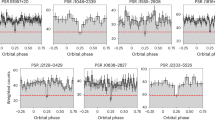Abstract
The recently discovered millisecond pulsar PSR1957 + 20 is eclipsed for ∼50 min out of each 9.16-h orbit1; several authors suggested1–4 that spin-down radiation from the pulsar is evaporating material from the surface of the ˜0.02Mṁ companion. Here we report observations intended to find the optical counterpart of the pulsar and to study luminosity variations with orbital phase. We show that the candidate optical counterpart5 is actually two stars, one the true counterpart, the other an unrelated background star. The luminosity of the system varies by at least a factor of five, with a maximum of magnitude 20.3 when the pulsar hides the companion. The phase of the variations implies that the light comes mostly from the companion star, and suggests that it is tidally locked, with the bright side constantly illuminated by the pulsar. The companion has a low colour temperature, ∼5,500 K, which with its magnitude and the pulsar's dispersion-measure distance indicates a radius of 0.15R⊙, about the size of a 0.02M⊙ hydrogen white dwarf.
This is a preview of subscription content, access via your institution
Access options
Subscribe to this journal
Receive 51 print issues and online access
$199.00 per year
only $3.90 per issue
Buy this article
- Purchase on Springer Link
- Instant access to full article PDF
Prices may be subject to local taxes which are calculated during checkout
Similar content being viewed by others
References
Fruchter, A. S., Stinebring, D. R. & Taylor, J. H. Nature 333, 237–239 (1988).
Kluzniak, W., Ruderman, M., Shaham, J. & Tavani, M. Nature 334, 225–227 (1988).
Phinney, E. S., Evans, C. R., Blandford, R. D. & Kulkarni, S. R. Nature 333, 832–834 (1988).
Van den Heuvel, E. P. J. & van Paradijs, J. Nature 334, 227–228 (1988).
Kulkarni, S. R., Djorgovski, S. G. & Fruchter, A. S. Nature 334, 504–506 (1988).
Gunn, J. E. et al. Optical Engineering 26, No. 8, 779–787 (1987).
Lauer, T. R., Stover, R. J. & Terndrup, D. M. Lick Observatory tech. Rep. No. 34 (1983).
Oke, J. B. & Gunn, J. E. Ap. J. 266, 713–717 (1983).
Kent, S. M. Publ. astr. Soc. Pacif. 97, 165–174 (1985).
Lyne, A. G., Manchester, R. N. & Taylor, J. H. Mon. Not. R. astr. Soc. 213, 613–639 (1983).
Neckel, Th. & Clare, G. Astr. Astrophys. Suppl Ser. 42, 251–281 (1980).
Weaver, H. & Williams, D. R. W. Astr. Astrophys. Suppl. 17, 1–249 (1974).
Spitzer Jr, S. Physical Processes in the Interstellar Medium 156–157 (Wiley, New York, 1978).
Rappaport, S., Nelson, L., Ma, C. P. & Joss, P. C. Astrophys J. 322, 842–851 (1987).
Author information
Authors and Affiliations
Rights and permissions
About this article
Cite this article
Fruchter, A., Gunn, J., Lauer, T. et al. Optical detection and characterization of the eclipsing pulsar's companion. Nature 334, 686–689 (1988). https://doi.org/10.1038/334686a0
Received:
Accepted:
Published:
Issue Date:
DOI: https://doi.org/10.1038/334686a0
This article is cited by
-
Discovery of a very bright, nearby binary millisecond pulsar
Nature (1993)
-
X-rays from the eclipsing pulsar 1957 +20
Nature (1992)
-
Is PSR1957 + 20 eclipsed by a comet, magnetosphere or particulate cloud?
Nature (1989)
-
Discovery of a nebula around PSR1957 + 20
Nature (1988)
Comments
By submitting a comment you agree to abide by our Terms and Community Guidelines. If you find something abusive or that does not comply with our terms or guidelines please flag it as inappropriate.



